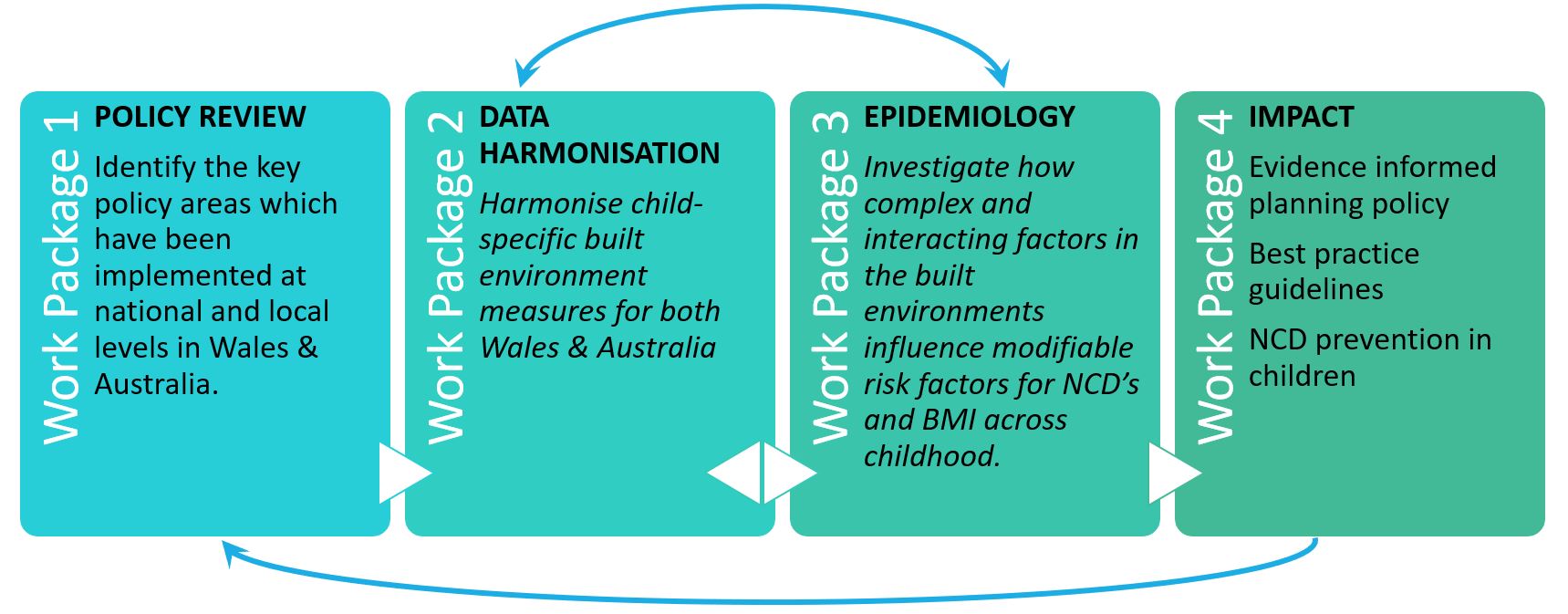The built environment in which we live is integral to human health. Living in neighborhoods with good access to shops, services, and quality parks, connected streets to facilitate walking, sufficient residential densities to support public transport services and local businesses, minimal crime, and opportunities for social connectedness, is associated with improved health outcomes in adults.
However, limited evidence exists on the role of the built environment in promoting child health. Stronger causal evidence is needed.
We want to know which aspects of the built environment can be modified to reduce the negative impact on children's modifiable risk factors for NCD's (physical inactivity, sedentariness, poor diet) and overweight/obesity. To answer this, we have five main objectives:
- Develop a comprehensive Geographic Information Systems (GIS) model of the child-specific built environment using standardised methods for Wales and Australia.
- Link the standardised GIS models of the BE to e-cohort and standard cohort data for children in Wales and Australia.
- Determine the direct and indirect relationships between the built environment both; modifiable risk factors for NCDs (physical activity, sedentary time, diet) and obesity.
- Identify how relationships between the built environment and these NCD risk factors vary by socio-economic position and geographical location (Wales and Australia)
- Produce evidence which policy makers can use to modify the built environment to reduce childhood obesity and NCDs.
To achieve these objectives, we will complete four Work Packages The work packages detailed below have been designed to enable us to compare and contrast the differences and similarities between built environments in Wales and Australia. This will allow us to define causal pathways for child NCD risk factors given the contrasting climates, geographies and policy approaches in Wales and Australia, ultimately leading to scientifically robust policy recommendations.

Our program of work will bring together five large cohort studies that have detailed anthropometric, physical activity, and contextual data on more than 1 million UK and Australian children.
Wales Data Sets:
-
The Wales Electronic Cohort for Children (WECC)
The WECC cohort is a total population anonymised electronic cohort study of all children born and living in Wales since 1990. The WECC dataset includes a wide range of individual linked datasets including, for example, health and education records. -
Millennium Cohort Study (MCS Wales)
The Millennium Cohort Study studies the social, economic and health-related circumstances of British children born at the start of this century. It includes children born between September 2000 and January 2002 who were living in England, Wales, Scotland and Northern Ireland, including representation from disadvantaged social circumstances and ethnic minoritie.
Australian Data Sets:
-
ORIGINS
The ORIGINS Project is a world class investigation into when and why NCDs develop, through the study of early environments, maternal and paternal physical health and genetics. The goal is to reduce the rising epidemic of NCDs through 'a healthy start to life'. ORIGINS is a collaborative initiative between the Telethon Kids Institute, University of Western Australia and Joondalup Health Campus, establishing a new University of Western Australia birth cohort that is fully integrated into clinical and diagnostic services.
-
PLAYCE cohort
The PLAY Spaces & Environments for Children's Physical Activity (PLAYCE) study is investigating the influence of the childcare, home and neighbourhood built environment (on young children's physical activity, sedentary time, diet and weight status
-
LSAC
The Growing Up in Australia: The Longitudinal Study of Australian Children (LSAC) is a prospective study that used a two cohort cross-sequential design and in 2004 recruited 5107 children to the baby cohort and 4983 children to the kindergarten cohort.